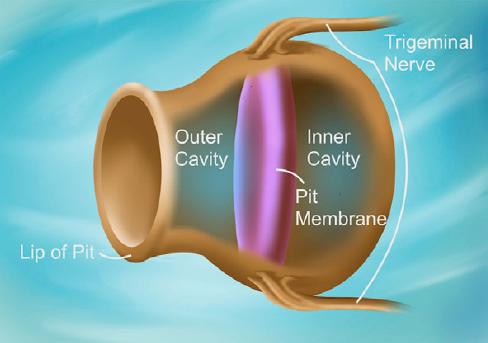
Vipers, pythons and boa constrictors all use infrared vision to locate their prey, but the exact source of this slithery sixth sense is unknown. A team of researchers at the University of Houston in the US has now developed a mathematical model for how cells in a specialized snake organ convert infrared radiation into electrical signals. As well as potentially solving a longstanding puzzle in snake biology, the work could also aid the development of thermoelectric transducers based on soft, flexible structures rather than stiff crystals.
Certain species of snake can generate unsettlingly accurate thermal images of objects that are warmer than their surroundings. Venomous pit vipers, for example, can detect infrared (IR) light at wavelengths between 50 nm and 1 mm, which translates into a frequency range of between 1.8 THz to 2.5 PHz. This heat-sensing ability enables them to hunt warm-blooded prey such as birds and rodents even in total darkness, and scientists believe that it derives from a structure in their heads that acts as an “antenna” for IR radiation. The structure, known as a pit organ, is a hollow chamber about 10 to 15 mm thick, encased in a thin membrane with a surface area of around 30 mm2.
A pyroelectric possibility
Despite extensive studies, the precise mechanism by which the pit organ converts infrared radiation into processable electrical signals remains controversial, notes team leader Pradeep Sharma. He and his colleagues have now constructed a mathematical model to test the theory that cells within the pit organ membrane are pyroelectric – that is, able to generate a temporary voltage when heated or cooled.
This idea is itself somewhat controversial, since pyroelectricity was previously thought to be limited to stiff materials such as crystals. These materials are naturally electrically polarized and so contain large electric fields. When they change temperature, the position of their atoms also changes slightly. This shift in position alters their polarization, which in turn produces a temporary voltage across the material. If the temperature then remains constant at its new value, the pyroelectric voltage slowly dissipates due to leakage current.
To show that snake cells could also act as pyroelectric materials, the researchers used methods from the continuum mechanics of soft matter to couple electric fields and thermal expansion strain. They also factored in material properties such as the elastic modulus and thermal expansion coefficients of the cells. Using these inputs, the researchers calculated that, based on the pyroelectric responses of their pit organ cells, boa constrictors and vipers ought to be able to detect temperature differences at the millikelvin level. This is better than any human-made heat sensor, and according to Sharma, it implies that the snakes can sense the presence of an animal that is a mere 10 degrees warmer than its surroundings, even if it appears for only half a second at a distance 40 centimetres away.

Darbaniyan et al. /Matter
Similar calculations for rattlesnakes and pythons indicate that they can perform the same feat at 100 cm and 30 cm, respectively. All three results agree qualitatively with physiological measurements, Sharma says.
Applications to synthetic materials
The new work shows that soft and flexible structures can indeed display pyroelectricity. Such structures, Sharma explains, contain embedded static, stable electrical charges that don’t leak out. They can also deform in shape and size and are sensitive to temperature.
The researchers are now undertaking preliminary experiments on synthetic soft materials that resemble a snake’s pit organ. The results of these experiments might confirm the new model, they say, although further research would still be needed to prove that the proposed mechanism is indeed occurring in the snakes’ cells. Previous biological studies suggested that protein channels known as TRPA1 were involved, but it remains unclear how these channels might relate to the new model.

Plasmonic nanocubes make an ultrafast thermal camera
“Using this model, I can confidently create an artificial soft material with pyroelectric properties – of that there is no doubt,” Sharma says. “And we are fairly confident that we have uncovered at least part of the solution of how these snakes are able to see in the dark.” Now that they’ve developed the model, he adds, other scientists can do experiments to confirm or disprove their theory about snakes’ IR-sensing abilities.
The researchers, who report their work in Matter, say they now plan to fabricate bespoke soft materials that are highly pyroelectric while also demonstrating the (converse) electrocaloric effect. “Here, applying an electric field can reduce the temperature and thus provide a sort of cooling,” Sharma tells Physics World. “Such an effect has only been appreciably demonstrated in hard materials so far.”



